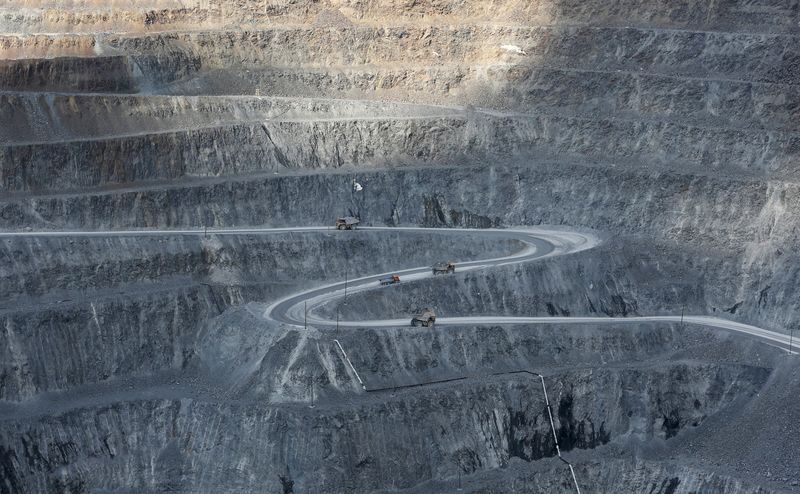Bitcoin price today: muted near $122k after record highs; US shutdown drags on
Investing.com -- Deutsche Bank (ETR:DBKGn) Research in a note has given its 2025 outlook for mining stocks, flagging a complex interplay of global economic uncertainty, geopolitical factors, and structural industry reforms.
The note flags critical themes expected to influence market dynamics, with a focus on tariffs, capacity control in China, consolidation through mergers, and broader corporate restructuring.
Together, these factors set the stage for a pivotal year for commodities and mining equities.
The backdrop to this is marked by major challenges in 2024, including subpar global metal demand and the impact of geopolitical tensions.
The outlook, however, is cautiously optimistic, with signs of recovery anticipated in the second half of 2025.
The analysts said that much of this recovery will hinge on the trajectory of global trade policies and stabilization of key markets.
Deutsche Bank’s central case forecasts range-bound metal prices in early 2025, followed by a rebound driven by improving demand outside China and easing economic pressures.
The note is anchored around five core themes, each expected to exert a profound influence on commodity markets and mining equities.
The impact of U.S. tariffs
The return of aggressive trade policies under the Trump administration could reshape global markets.
The imposition of tariffs, particularly on Chinese metals, is expected to provide a lifeline to U.S.-based steel producers, while creating headwinds for copper—a commodity highly sensitive to global trade and growth.
Deutsche Bank’s projections suggest that an internationally cooperative approach, such as moderate tariffs coupled with stronger trade diplomacy, could spark a rally in metals, including copper, which is currently undervalued relative to demand fundamentals.
A Russia-Ukraine ceasefire
A potential ceasefire between Russia and Ukraine is viewed as a pivotal event that could stabilize energy markets and boost global risk appetite.
For the mining sector, the rebuilding of Ukraine’s infrastructure is poised to drive demand for steel and other key materials.
However, a resolution may also lead to a normalization of energy-intensive metal prices, such as aluminium, where Russian production plays a major role in global supply chains.
European steel producers stand to benefit significantly from reduced energy costs and renewed demand from reconstruction projects.
China’s capacity controls
China’s policies on metal production remain a cornerstone of the global mining narrative.
Measures like aluminium capacity caps and export tax rebate removals are aimed at addressing oversupply, boosting domestic margins, and improving international trade relations.
These changes could tighten global supply, creating an upside for companies like Norsk Hydro (OTC:NHYDY), which is well-positioned to benefit from these shifts.
Similarly, reforms in China’s steel sector, designed to curb overcapacity and reduce export surpluses, may alleviate global pricing pressures and strengthen margins for Western producers.
Consolidation through M&A
The note flags a resurgence in merger and acquisition activity, driven by major players’ strategic shifts towards copper and other green metals essential for the energy transition.
With underinvestment in greenfield mining projects and rising demand for these commodities, consolidation is viewed as a necessary response to structural challenges.
Companies like Anglo American (JO:AGLJ), Teck, and First Quantum (NASDAQ:QMCO) are identified as potential acquisition targets, reflecting the broader industry trend towards streamlining portfolios and enhancing operational efficiency.
Corporate restructuring and U.S. listings
In a bid to unlock value, several European mining companies are pursuing corporate restructuring and exploring U.S. listings.
Firms such as Glencore (OTC:GLNCY), ArcelorMittal (NYSE:MT), and Acerinox (BME:ACX) are reassessing their structures to appeal to more favorable valuation environments in U.S. markets.
These moves are expected to realign their operations, simplify portfolios, and potentially enhance shareholder returns.
Deutsche Bank remains optimistic about a rebound in commodity prices in the latter half of 2025.
Aluminium is positioned as a standout, benefitting from constrained Chinese production and increasing demand.
Copper, despite near-term vulnerabilities tied to global trade uncertainty, is projected to enter a structural deficit by late 2025, supporting higher prices.
Conversely, the outlook for iron ore is less favorable, with the market likely facing sustained surpluses due to declining Chinese demand and increasing global supply.
Among the top equity picks, Anglo American is lauded for its strategic simplification efforts and exposure to high-margin copper assets.
Norsk Hydro is positioned to benefit from aluminium’s tightening supply dynamics, while Rio Tinto (NYSE:RIO) remains the preferred iron ore name, offering defensive qualities amid market volatility.
Glencore, with its strong cash flows and potential for a U.S. listing, is another standout recommendation.
Should you invest $1,000 in DBKGn right now?
Ask WarrenAI, our powerful AI financial research assistant. It's just like ChatGPT for investors, but with access to 10 years of company data, a built-in screener, Wall Street analysts' reports, and earnings call transcripts for real-time, vetted insights.
Get answers about DBKGn and thousands of other assets within seconds.
